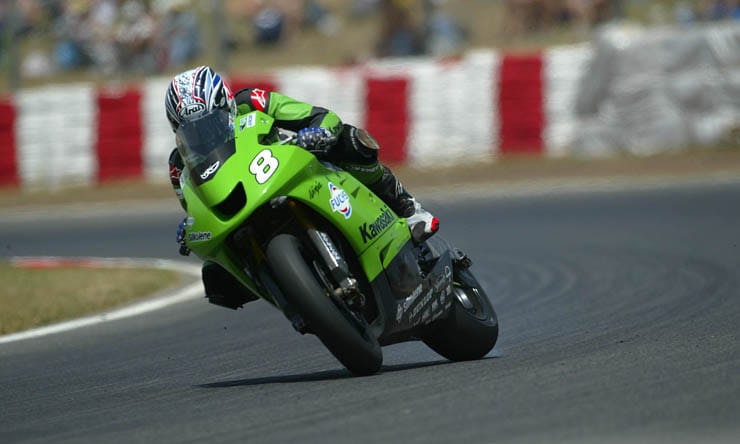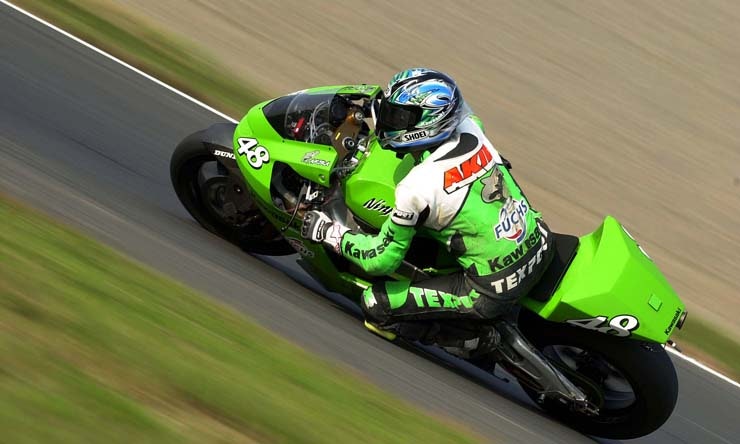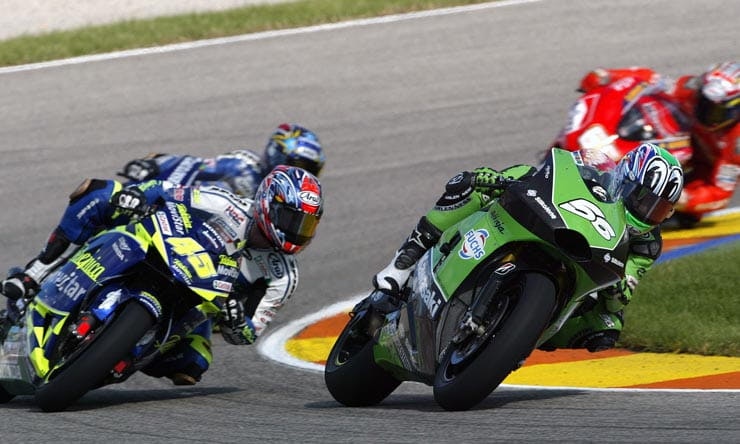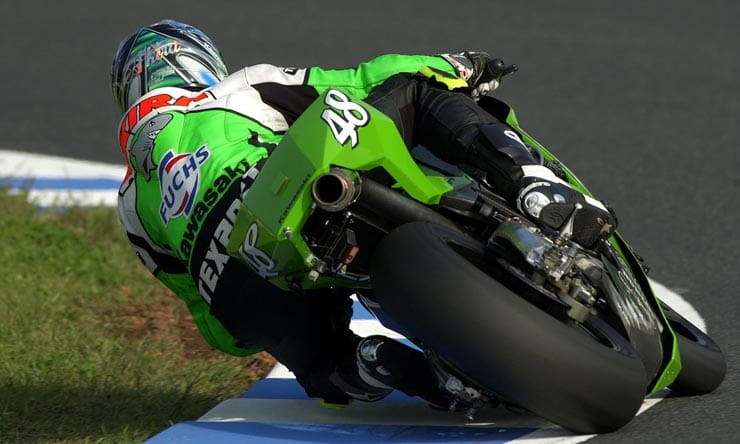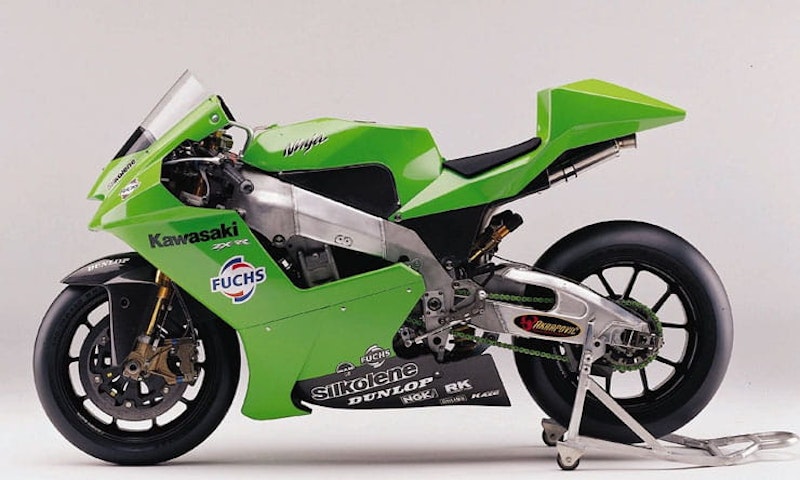We’ve already covered the histories of the main players in the first 15 years of the four-stroke MotoGP championship but those smaller characters that have dipped in and out of the series are just as vital in its enduring success.
In this fifth part we’re looking at Kawasaki – a company that never quite managed to hit the right notes in MotoGP but which has perhaps had the closest connection of all between its road and race machines. Does the latest ZX-10R’s winning streak in world superbikes owe something to the unloved and unsuccessful MotoGP machines?
Gestation of the ZX-RR
After rumours in 2000 that Kawasaki would return to MotoGP in the four-stroke era, the company made an official announcement in early 2001 that it was to build a prototype for the new championship.
Initially, the firm released only a stylised sketch of a possible race bike, revealing the ZX-RR name but giving away nothing about its technical direction. The company also said it wouldn’t be running in the series until 2003, and would drop its world superbike efforts after 2002 to concentrate on the new MotoGP championship.
Akira Yanagawa was engaged as test rider for the project, and Kawasaki took the unusual step of developing its machine largely in public. The lax regulations of the All-Japan Road Racing series meant that it could compete on a ‘ZX-7R’ that was, in effect, a precursor to the MotoGP machine. First spotted testing in Malaysia in early 2002, the ZX-7 mule went on to race during the year, and gradually evolved into a MotoGP machine.
The chassis, starting life as a ZX-7R, gained prototype thin-walled cast sections at both the headstock and swingarm pivot area. The former allowed air to flow through a nose intake straight through the steering head rather than being routed around the sides as on the ZX-7R. The latter altered the bike’s geometry and rigidity as well as losing the seat supporting structures from the original road bike.
The inline-four engine again started life with its basis in the production ZX-7R motor, but quickly evolved to be a true 990cc prototype, sharing no components with the road bike. As well as allowing more power, the prototype status was required by MotoGP rules which banned production-derived components.
Odd technology initially used on the ZX-RR prototypes included a flat-slide fuel injection setup. Basically it was like a Kehin FCR carb but with an injector hung over the intake trumpet. The idea was similar to the theory behind slide carbs, in that when the throttle was wide open the slide would disappear completely from the intake, leaving a clear tract and allowing more airflow. In contrast, a butterfly always remains in the airstream, even when it’s wide open. By combining the idea with electronic fuel injection the hope was to improve the notoriously tricky part-throttle control associated with flat-slide carbs.
The bike’s GP-style bodywork replaced ZX-7R cowls in mid-2002, appearing at the fourth round of the All-Japan Road Racing series.
At the end of 2002, Kawasaki made the leap to MotoGP, with Yanagawa riding in the Pacific GP at Motegi in October of that year. He crashed, and was replaced by Andrew Pitt for the following rounds (last in Malaysia, second last in Australia, third-last in the Valencia finale.)
2003 ZX-RR
While Kawasaki’s prototype had appeared in MotoGP at the end of 2002, that had been more of a public test session than a real effort to race. For 2003, the firm mounted a real effort, with a three-rider team and a heavily revised bike.
The ZX-RR had looked frankly weird in 2002. Its bodywork looked like origami – all straight edges and sharp folds, with a bulky tail and under-seat exhaust. The 2003 version raced by Garry McCoy and Andrew Pitt was a much cleaner shape, even if the mechanical bits underneath were still recognisable. Test rider Alex Hofmann also raced in a handful of rounds.
The ZX-7R-derived frame remained, albeit with further improvements to the cast sections, as did the swingarm, which was basically identical to the unit used on the last of Kawasaki’s world superbikes. The bike’s top speeds suggested power was down on the best of its rivals, with top speeds often 10km/h down on the best, and its delivery also left something to be desired.
The season was dismal. Only twice would the ZX-RR break into the top 10, with McCoy’s ninth place in France and Hofmann’s 10th at Assen, and usually it brought up the rear. The riders ended 22nd (McCoy), 23rd (Hofmann) and 26th (Pitt) in the championship.
Positives? Well, the ZX-RR might have killed his top-line MotoGP career but video clips of McCoy spectacularly sliding the Dunlop-shod 2003 ZX-RR still regularly show up on the web to this day, so over the years the bike has got more exposure than its race results ever earned. Every cloud…
2004 ZX-RR
Something had to change for Kawasaki’s second full season, and it did. The 2004 bike was visually and technically a leap forward from its predecessor, Hofmann was promoted to a full-time ride alongside new signing Shinya Nakano, leaving McCoy and Pitt in the looking elsewhere.
An ugly duckling at the start of its career, for 2004 the ZX-RR evolved into a real looker. New fairings dispensed with some of the wackier aerodynamic ideas of the earlier bike, and the whole thing appeared smaller than before. The frame was also new, and finally there was a purpose-made swingarm instead of the world superbike hand-me-down.
On the engine side, power was improved and so was its delivery, but top speeds at Mugello – often a good indicator of outright power – still showed Kawasaki was lacking on that front, around some 14km/h down on the best (Hofmann’s 329km/h vs 343km/h for the Honda RC211V of Alex Barros). Tyres changed from the uncompetitive Dunlops to the still developing Bridgestones, which proved very competitive at certain circuits.
Overall, the Kawasaki’s results were a huge improvement. Nakano was a regular top 10 finisher and got the firm’s first podium with third in Japan, on his way to 10th in the championship. As a manufacturer, Kawasaki’s 2004 results hiked it above Suzuki for fourth place in the final standings.
2005 ZX-RR
The 2005 ZX-RR started the year looking near-identical to its predecessor but it evolved gradually – gaining new parts including updates to the geometry and aerodynamics as the year went on.
On the chassis side, like all its rivals, the Kawasaki’s swingarm got gradually bigger and bulkier as ever more rigidity was demanded. The frame was also new, despite looking much the same as before. It was evolving into a bike that riders could get the best out of, as demonstrated by Nakano’s consistent top 10 placings during the year.
The firm also debuted a new big-bang firing order to help tame the bike’s power delivery, bringing the bike into line with most of its rivals.
But power and straight-line speed were still nowhere to be found – at Mugello in 2005 the two Kawasakis could only beat the backmarker Blata WCM bikes on top speed. The fastest machines were nearly 20km/h quicker down the straight.
In the final counting Kawasaki again managed fourth in the manufacturer standings, beating Suzuki, and Nakano was 10th in the rider’s championship.
2006 ZX-RR
There were big changes again for 2006, with the appearance of a ZX-RR that was basically a new bike.
On the engine front, the motor was redesigned to move the gearbox higher up and shorten the overall package, while internal alterations let it rev higher and make more power. The chassis, meanwhile, stuck with 2005’s geometry but was redesigned to suit the tighter engine packaging, making the whole bike physically more compact.
The bodywork marked another step forward, with a new look and refined aerodynamics.
In terms of results, though, the bike didn’t reward Kawasaki’s efforts. Nakano remained on board and was joined by Randy de Puniet on the second bike. Assen proved a surprise, though. In a race that most remember for Colin Edwards’ last-corner off – the closest the Texan ever came to a MotoGP win – and Hayden’s resulting victory, Nakano scored second place for Kawasaki. He’d also qualified in second, suggesting a breakthrough with the bike, but it never reached such heights again.
By year’s end, Kawasaki had slipped to sixth in the manufacturer championship, behind not only Suzuki but also the Honda-powered Roberts KR211V.
2007 ZX-RR
It was all change for 2007. The new MotoGP 800cc capacity limit meant that everyone came to the party with bikes that were virtually all-new, and Kawasaki was no exception.
While the ZX-RR stuck with the same inline-four layout, it had a new 800cc pneumatic valve motor and a suitably redesigned chassis to sit it in. New styling completed the transformation.
The team also saw upheaval, with a new European Kawasaki subsidiary taking control of MotoGP activities from Harald Eckl, who’d previously run the operation.
In testing, the bike looked like a transformation from the previous generation. While Kawasaki had previously lagged on top speed, the 2007 ZX-RR was among the fastest in a straight line. While Ducati’s 2007 bike was a missile, normally topping the speed charts, the Kawasaki came close. At Mugello de Puniet’s 317km/h was fifth quickest behind four Ducatis. To leap ahead of Honda, Yamaha and Suzuki on power should have been a great advantage, particularly since the ZX-RR usually handled well.
The results weren’t so good, though. Nakano had defected to Honda, leaving de Puniet to lead the team (Olivier Jacques and Anthony West would share duties on the second bike).
While most of de Puniet’s finishes were in the top 10, and he managed second in Japan, there were too many retirements. He ended the season 11th. Kawasaki came fifth in the manufacturer standings, behind all the other major factory teams.
2008 ZX-RR
For 2008 the ZX-RR looked much like the previous year’s bike, but during testing the firm experimented with a return to the screamer engine configuration that it had last used in 2004. Advances in traction control and engine management systems meant that the additional top-end power of a screamer engine was now more usable than it had been a few years earlier, but the team eventually stuck with the big-bang engine for the race season.
In results terms, Kawasaki’s more promising 2007 performance seemed to evaporate in 2008. As Honda and Yamaha, wrong-footed in 2007, came back on terms with Ducati, Kawasaki got left behind once more. On top speeds, the ZX-RR was again towards the tail of the field. Riders John Hopkins and Ant West managed only 16th and 18th in the championship, with Kawasaki fifth and last in the manufacturers championship.
2009 ZX-RR
Blaming the economic collapse, Kawasaki withdrew from MotoGP before the start of the 2009 season, but not before it had developed a new bike for that year.
The 2009 ZX-RR again had a redesigned frame and swingarm, with a more refined engine to go with them, and was raced by a new outfit – Hayate Racing Team – which was basically a scaled-down version of the previous squad. Just one bike was fielded for Marco Melandri.
Ironically, after distancing itself from the racing efforts, Kawasaki wasn’t able to bask in the glory from some of the ZX-RR’s best results, which came in early 2009. Melandri dragged the underfunded bike to a series of top 10 finishes and matched the ZX-RR’s best-ever second place finished at the French GP, albeit a gaping 17 seconds behind winner Jorge Lorenzo.
At the end of the season, Hayate was wound down and Kawasaki’s involvement in MotoGP came to an end.
The ZX-RR’s effect on production bikes
While other bikes in this series have led to immediately recognisable influences on road-going machines, with the ZX-RR’s conception the flow of influence initially went the other way. The bike was clearly derived from a production ZX-7R in its first form, only to evolve away from the showroom machine as time went on.
Kawasaki never made close ties in terms of styling between its road and race bikes, although there are arguably hints of the original ZX-RR in the 2003-4 ZX-6R’s shape. Of course, the ZX-RR’s inline engine and alloy beam frame were always in the same vein as production models, but direct feedback from the project onto road bikes is hard to point out.
